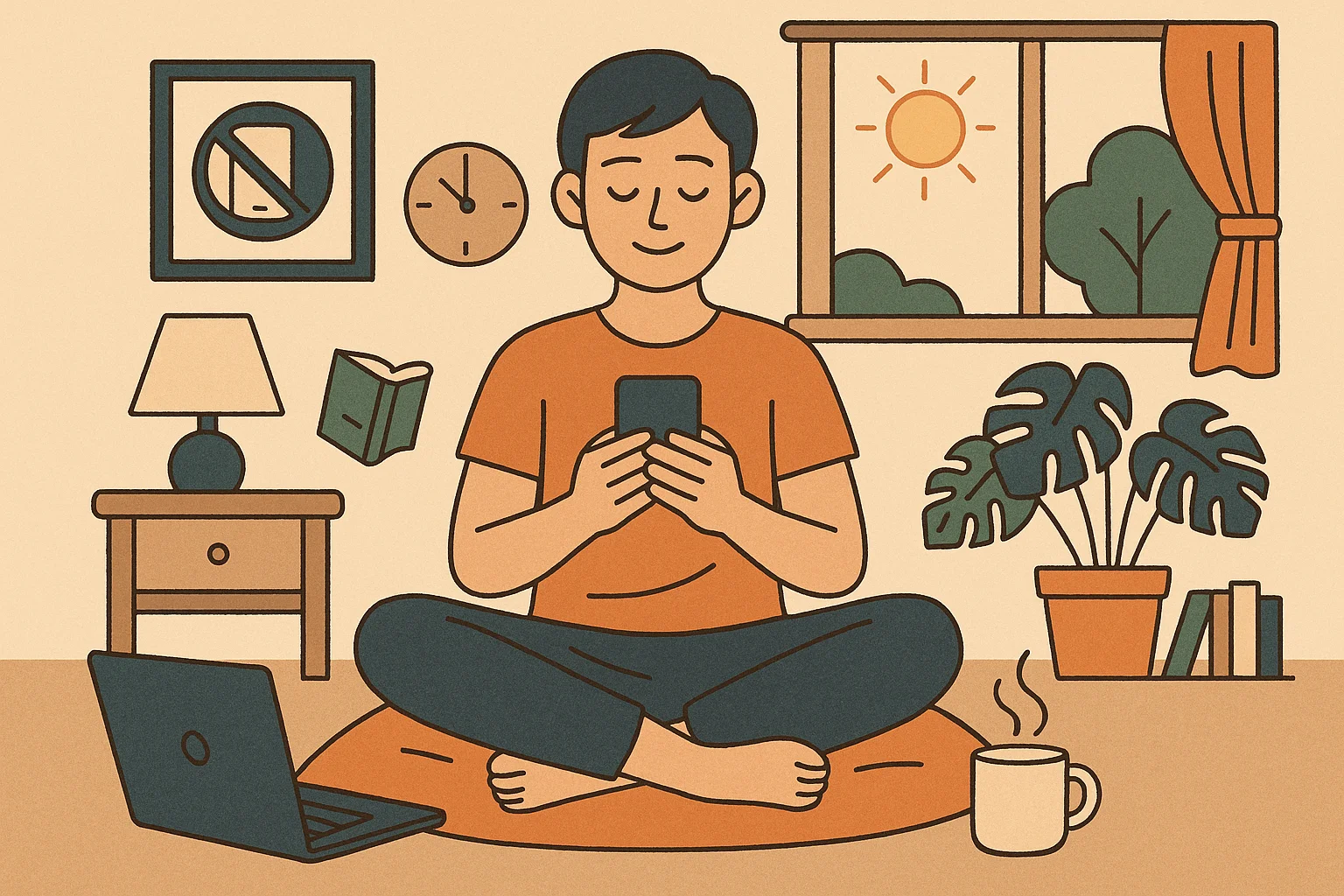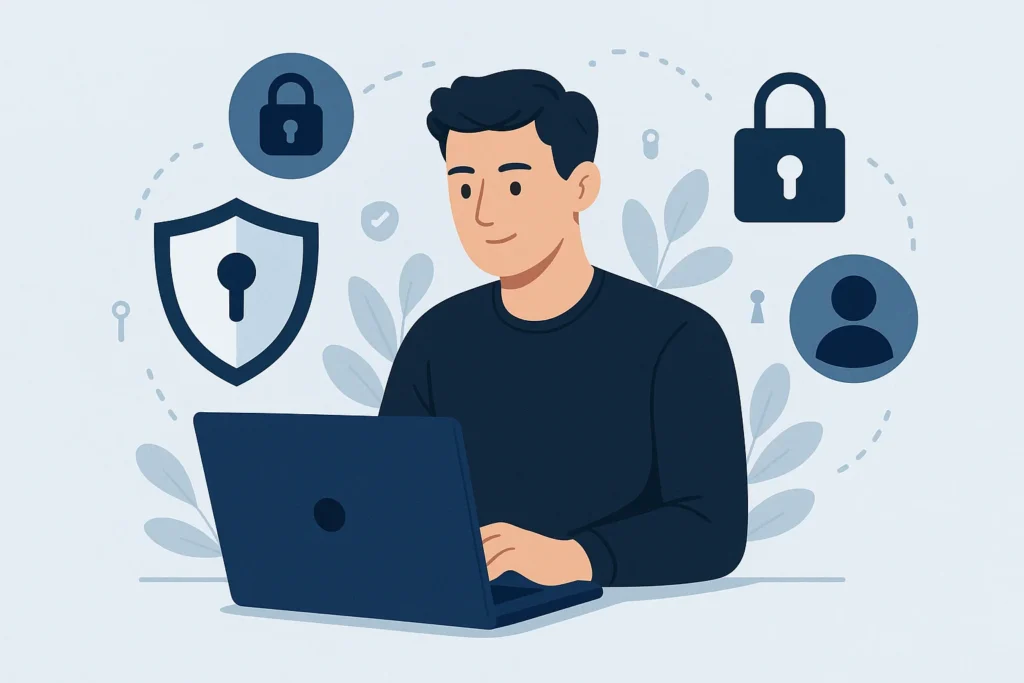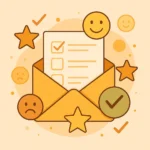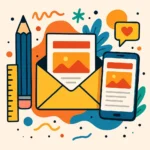Now Reading: 10 Healthy Digital Habits for Daily Life Balance
-
01
10 Healthy Digital Habits for Daily Life Balance
10 Healthy Digital Habits for Daily Life Balance

I used to lose hours to my phone, constantly distracted by notifications and endless scrolling. My productivity suffered, my sleep deteriorated, and my relationships felt the impact. Sound familiar? Developing healthy digital habits for daily life isn’t just helpful anymore-it’s essential. With over 294 million smartphone users in America alone, nearly half admitting to phone addiction, our relationship with technology directly shapes our wellbeing. Let me share how I transformed my digital life and how you can too.
Key Takeaways
What are healthy digital habits to adopt in daily life?
- Set clear boundaries by creating tech-free zones and times in your home and schedule
- Practice mindful consumption by being intentional about the content you engage with
- Take regular digital detoxes to reset your relationship with technology
- Prioritize real-life relationships over digital connections
- Implement the 20-20-20 rule to protect your eye health during screen time
- Use technology purposefully rather than mindlessly
- Establish healthy sleep routines by avoiding screens before bedtime
- Organize your digital space to reduce stress and increase productivity
Set Clear Boundaries with Technology
Creating boundaries around technology use has been game-changing for my wellbeing. I’ve established tech-free zones in my home, including the dining table and bedroom. This helps me be more present during meals and improves my sleep quality.
Time boundaries are equally important. I schedule specific times to check email and social media rather than responding to every notification immediately. This prevents technology from controlling my day and allows me to focus on important tasks without constant interruption.
Practical tip: Use your phone’s built-in tools like Screen Time (iOS) or Digital Wellbeing (Android) to set app limits and schedule downtime. These features help enforce the boundaries you set.
Useful Articles:
Practice Mindful Consumption
Being intentional about what content I consume has dramatically improved my digital wellbeing. Instead of mindlessly scrolling through whatever algorithms serve up, I carefully curate my feeds and choose content that adds value to my life.
Mindful consumption means:
- Unfollowing accounts that trigger negative emotions or comparison
- Selecting news sources carefully to avoid information overload
- Choosing educational or inspiring content over endless entertainment
- Being aware of how different types of content affect my mood and energy
When I notice myself falling into passive consumption habits, I pause and ask: “Is this adding value to my day?” If not, I redirect my attention to something more meaningful.
Schedule Regular Digital Detoxes
Taking planned breaks from technology has helped me reset my relationship with my devices. These digital detoxes can range from a few hours to several days, depending on what works for your lifestyle.
I started small by implementing device-free evenings once a week. During this time, I engage in offline activities like reading physical books, practicing hobbies, or connecting with friends and family in person. These breaks have become something I look forward to rather than dread.
For longer detoxes, I plan weekend getaways where I limit technology use to essentials only. I’ve found that after these breaks, I return to technology with greater awareness and intention.
Useful Articles:
Prioritize Real-Life Relationships
One of the most important digital habits I’ve developed is prioritizing face-to-face interactions over digital connections. While technology can help us stay connected with distant loved ones, it shouldn’t replace meaningful in-person relationships.
I make it a point to be fully present during social gatherings by keeping my phone out of sight. This not only strengthens my relationships but also sets a positive example for others.
Practical tip: Create a “phone stack” during gatherings where everyone places their phones in the center of the table, face down. The first person to check their phone pays for coffee or dessert!
Implement Ergonomic Practices
Protecting my physical health while using technology has become a priority. I’ve set up an ergonomic workspace with:
- A properly positioned monitor at eye level
- A supportive chair that promotes good posture
- Regular movement breaks to prevent stiffness
- Proper lighting to reduce eye strain
These adjustments have significantly reduced the physical discomfort I used to experience after long workdays at the computer.
Useful Articles:
Creating a Healthy Digital Morning Routine
How I start my day sets the tone for my relationship with technology. I’ve found that establishing a healthy digital morning routine helps me maintain balance throughout the day.
Delay First Screen Check
One of the most impactful changes I’ve made is not checking my phone immediately upon waking. I used to reach for my device before my feet hit the floor, which meant starting my day reacting to others’ needs and information.
Now, I wait at least 30 minutes before checking any devices. This gives me time to set my own intentions for the day rather than being influenced by emails, news, or social media. During this time, I focus on activities that center me, like meditation, journaling, or exercise.
Use Technology Purposefully
When I do incorporate technology into my morning routine, I do so with purpose. Rather than aimlessly browsing, I might:
- Listen to an educational podcast while preparing breakfast
- Use a meditation app for guided morning practice
- Check my calendar to review the day’s priorities
- Read one quality news source rather than endless headlines
This intentional approach helps me use technology as a tool rather than allowing it to use me.
Healthy Digital Habits at Work
Since most of us use technology extensively for work, developing healthy digital work habits is crucial for productivity and wellbeing.
Batch Process Communications
Constantly checking email and messages throughout the day fragments attention and reduces productivity. I’ve adopted batch processing-checking and responding to communications at designated times rather than continuously.
I typically check email three times daily: morning, midday, and before ending work. This allows me to focus on deep work during the intervals while still remaining responsive to colleagues.
Practical tip: Set an email auto-responder informing people of your checking schedule and providing alternative contact methods for urgent matters.
Use the Pomodoro Technique
The Pomodoro Technique has revolutionized my work habits. This method involves:
- Working with complete focus for 25 minutes
- Taking a 5-minute break away from screens
- Repeating this cycle four times
- Taking a longer 15-30 minute break
During focused work periods, I close email, silence notifications, and use website blockers to prevent distractions. The regular breaks give my eyes and mind rest while improving overall productivity.
Organize Your Digital Workspace
A cluttered digital environment creates mental stress just like physical clutter. I regularly organize my:
- Computer desktop (keeping it clear of random files)
- Email inbox (using folders and filters)
- Browser bookmarks (organizing by category)
- Digital files (maintaining a logical folder structure)
This organization reduces the cognitive load of navigating digital spaces and helps me work more efficiently.
Evening Digital Habits for Better Sleep
The way we use technology in the evening directly impacts our sleep quality. I’ve developed specific habits to ensure technology doesn’t interfere with rest.
Implement a Digital Sunset
I practice a “digital sunset” by powering down non-essential devices at least one hour before bedtime. This allows my brain to begin producing melatonin naturally, which is often suppressed by blue light from screens.
During this screen-free time, I engage in calming activities like reading physical books, gentle stretching, or conversation with family. This transition period signals to my body that it’s time to prepare for sleep.
Use Night Mode and Blue Light Filters
When I must use devices in the evening, I activate night mode and blue light filters on all screens. These features reduce the blue light emission that interferes with melatonin production.
Most devices now have built-in features for this purpose:
- Night Shift on iOS devices
- Night Light on Android
- Night mode on Windows
- Night Shift on macOS
I’ve also invested in blue light blocking glasses for additional protection during evening screen use.
Create a Phone-Free Bedroom
Perhaps the most significant change I’ve made is keeping phones and tablets out of the bedroom entirely. I use a traditional alarm clock rather than my phone and charge devices in another room overnight.
This eliminates the temptation to check devices during the night and prevents the first and last moments of my day from being dominated by digital content.
Social Media Mindfulness
Social media presents unique challenges for digital wellbeing. I’ve developed specific habits to maintain a healthy relationship with these platforms.
Curate Your Feed Intentionally
I regularly audit and curate my social media feeds to ensure they contain content that inspires, educates, or genuinely connects me with people I care about. This involves:
- Unfollowing accounts that trigger negative emotions
- Muting keywords or topics that cause stress
- Following diverse perspectives that broaden my thinking
- Limiting the number of accounts I follow to reduce overwhelm
This curation transforms social media from a source of stress to a tool for positive connection and growth.
Set Time Limits for Social Platforms
Even with a well-curated feed, social media can consume excessive time through endless scrolling. I use app timers to limit my daily usage of each platform-typically 15-30 minutes per day.
When I reach these limits, I receive a notification that helps me become aware of my usage and make a conscious choice about whether to continue. Often, this awareness is enough to help me put the device down and engage in other activities.
Practice the One-Screen Rule
Multitasking with multiple screens-like browsing social media while watching TV-fragments attention and increases overall screen time. I practice the one-screen rule, focusing on a single device at a time.
This mindful approach helps me fully engage with the content I’m consuming rather than splitting my attention, which often leads to increased time on devices without increased satisfaction.
Digital Security Habits
Protecting personal information is an essential aspect of digital wellbeing that many overlook. I’ve incorporated these security habits into my digital routine.
Use Strong, Unique Passwords
I use a password manager to create and store strong, unique passwords for each online account. This prevents the catastrophic domino effect that can occur when a single password is compromised.
Password managers also reduce the cognitive burden of remembering multiple complex passwords, making it easier to maintain good security habits.
Enable Two-Factor Authentication
For sensitive accounts like email, banking, and social media, I enable two-factor authentication (2FA). This additional security layer requires something I know (my password) and something I have (typically my phone) to access accounts.
While this adds an extra step to the login process, the security benefits far outweigh this minor inconvenience.
Regularly Update Privacy Settings
I schedule quarterly reviews of privacy settings on my most-used platforms and devices. During these reviews, I:
- Check which apps have access to my location, contacts, and other data
- Review and adjust social media privacy settings
- Update sharing preferences on cloud services
- Revoke access for apps and services I no longer use
These regular checks help me maintain control over my personal information in an ever-changing digital landscape.
Developing healthy digital habits for daily life isn’t about rejecting technology-it’s about using it intentionally to enhance rather than detract from our wellbeing. By setting boundaries, practicing mindful consumption, and regularly disconnecting, we can enjoy the benefits of our digital world while maintaining balance and presence in our lives. Start with one small change today, and build from there. Your mind, body, and relationships will thank you.
Useful Articles:





















